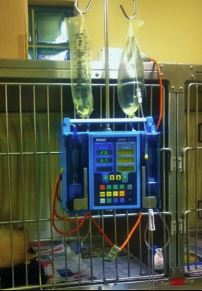Did you know there are more than 25 different venomous snakes in Australia?
The mere thought of encountering one makes me break out in a cold sweat. I should definitely consider moving to a nice, snake-free country like New Zealand!
More than three quarters of snake bites across the country are from brown snakes, but here in Victoria around fifty percent are from Tiger snakes.
Snake bites are really very common in our pets, and are generally seen any time from September through to April, with most cases over summer.
We’re seeing around one a week in the vet clinic at the moment, and that’s in suburbia!
The worst bites often occur when the weather first warms up and the snakes start to become active, because these first bites of the season are from full venom glands. The severity of symptoms and how quickly they occur also depends on how many times a pet is bitten and where on their body they are bitten. Unfortunately it is often on the face, as this is the body part they usually are poking at the snake.
Avoidance: Snakebite risks to our dogs

If you decide to do some summer bushwalking or hiking with your dog, take extra special care near water sources and around long grass.
Keep your dog on a lead rather than letting him run free, and stick to paths or tracks if possible.
Snakes generally aren’t aggressive and don’t seek confrontation, so staying alert and keeping out of their way is the best way to prevent a bite.
Most bites to humans occur when they are trying to capture or kill the snake.
Snakes also like to hide in places like woodpiles or under sheets of corrugated iron. I vividly remember lifting a sheet of this on my grandparents’ farm as a child and the terrifying discovery of a young snake warming itself underneath. If you have areas with these sorts of things lying around it’s best to tidy up what you can and keep your dog away from what you can’t.
What’s actually in snake venom?
Australian venomous snakes are all part of one big snakey family called Elapidae. The venom from elapid snakes is pretty complex, and does a number of horrible things. The main issues it causes are paralysis due to neurotoxins, muscle damage due to myotoxins, and bleeding tendencies due to coagulation system toxins.
Signs of Snakebite in Dogs
The signs vary because there are several factors involved including the species and age of the snake and where on its body the dog is bitten. I’ll just include the most common signs here, though others are possible.
Generally brown snake envenomation causes paralysis and bleeding tendencies, while tiger snake bites cause muscle damage as well. There are two main stages possible after a snakebite.
The Pre-Paralytic syndrome – Collapse and Vomiting
Dogs may collapse and vomit soon after being bitten. Other signs we might see at this stage include salivation, trembling, and rapid breathing.
The pre-paralytic syndrome is vitally important. Any dog that experiences this syndrome has received a lethal dose of venom. On top of this, these symptoms are often followed by what looks like recovery. The dog seems to be okay so prompt treatment is not sought. If a dog that has been bitten by a snake vomits and collapses, the worst is yet to come. Get to a veterinary clinic immediately.
Paralytic Signs – Dilated Pupils, Weakness, Paralysis and Death
This stuff is really not very nice to read about, but being aware of the signs just might save your dog’s life.
Around two to six hours after being bitten by a snake, a dogs pupils will become large and unresponsive to light.
They become weak in their hind legs which can make them stagger around a bit like they’re drunk. Over a short time this progresses to involve the front legs as well, and then worsens until the dog is paralysed.
At this stage the dog will be lying on its side, unable to even lift its head. Breathing becomes more and more difficult. This leads very quickly to death.
What to do if your dog is bitten by a snake
Keep your dog as quiet as possible and get them straight to your vet. There is honestly nothing you can do at home. If you are hiking or camping and are a long way from a veterinary clinic you can apply a pressure bandage over the bite site, but this really only has potential benefit if the bite is on a limb, and obviously isn’t an option for a dog that is bitten on the face.
A dog that has received a bite from a venomous snake needs antivenom and intravenous fluids at a veterinary clinic. Reported survival rates in dogs range from 75 – 91% for those that receive antivenom, down to 31% if they don’t.

What NOT to do
While it may be helpful for a vet to know what type of snake was involved, please, oh god please, do not try to catch or kill the snake. You won’t be able to help your dog from the back of an ambulance! Snakes are actually really difficult to identify anyway, varying substantially in appearance within a single species. There are tiger snakes without stripes and the two snakes below are both brown snakes.
If you can see where your dog has been bitten, it’s best not to wash the bite site. Some vets may use this to obtain a sample for use in a venom detection kit.
Do not apply a tourniquet.
How Do We Treat Snakebite in Dogs?
Antivenom vials contain enough antivenom to neutralize one average venom yield. What this means in practical terms is that the antivenom needed by an individual dog does NOT have anything to do with the size of the dog. It relates to the amount of venom injected during the bite and how many times the dog has been bitten.
Antivenom is really expensive. It’s made by gradually making horses immune to the venom, collecting some of their blood, and harvesting the antibody-containing serum. This is quite involved, and on top of that the antivenom also has a limited shelf life.
Affected dogs need to be hospitalized for administration of antivenom and intravenous fluid therapy. They need to be monitored carefully for deterioration in their condition, signs implying a need for a second vial of antivenom, and signs of an allergic reaction to the antivenom itself. Some more severely affected patients may require oxygen therapy or even mechanical ventilation if they can’t breathe for themselves. They require constant monitoring and nursing care. For these reasons treatment for snake envenomation can cost thousands of dollars.

In Summary: How to avoid snakebites to your dog & what to do in the event of a snakebite
1. Be Prepared and Minimise Risk
- Before going for a bushwalk or hike try to find out if there are expected to be snakes in the area.
- Use your judgment based on the area and surroundings and keep your dog on lead if there is a risk.
- Don’t let your dog run around near water sources or in long grass
2. Know the Signs of Snakebite
You may not actually see your dog get bitten, but if there is vomiting and collapse, excessive salivation and trembling, or your dog becomes weak in the hindlegs, it should be considered an emergency until proven otherwise. Get to the nearest veterinary clinic as quickly as possible.
3. First Aid
Unfortunately there isn’t much that can be done prior to receiving veterinary care. Keep your dog as calm and quiet as possible and consider a compression bandage if appropriate.



Leave a Reply